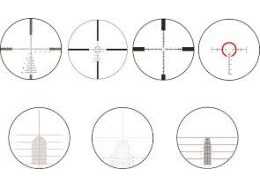How To Choose The Right Reticle For Your Needs
- Posted By Jeff Byrnes
- Blog
 The reticle, or more properly reticule, is the arrangement of aiming point or points that you see when you look through a rifle or crossbow scope. The most commonly used term for reticle is also the most common shape, the crosshair. Back in the day, actual hairs were crossed inside the scope to create an aiming point, but we’ve gotten past that now.
The reticle, or more properly reticule, is the arrangement of aiming point or points that you see when you look through a rifle or crossbow scope. The most commonly used term for reticle is also the most common shape, the crosshair. Back in the day, actual hairs were crossed inside the scope to create an aiming point, but we’ve gotten past that now.
There are plenty of different options for reticles, but the basics of choosing your crosshair is pretty simple. The finer, or smaller, the intersection of the crosshairs, the more precise of an aiming point you get. At the same time, really fine intersections can be difficult to see in low light.
What this means, essentially, is that you have to choose your reticle based on how you’re going to use your scope. A very fine crosshair that lets you see through the intersection and establish an aiming point on a rabbit from 300 yards is ideal for long-range varmint hunting, but you don’t need such a fine crosshair for larger game at shorter distances.
The best shape for a reticle
The Burris Ballistic Plex is probably the most useful type of reticle out there. It features thick lines on the outside of the crosshair, which tapers to much thinner hairs as you approach the intersection. What this design does is give your eyes a quick focus mechanism to find the intersection, since your eyes can easily pick up the thicker lines and then move in to the center.
More advanced reticles
So how do you decide? Well, hold on, because we haven’t even covered some of the more complex aspects of choosing a reticle yet. You see, reticles have advanced far beyond just having two lines crossing one another. We also have range compensating dots or lines on some reticles, allowing you to accurately aim your shot at a variety of distances.
Complicating matters even more, you have MilDot reticles that can actually be used to calculate distance to target. This is time-consuming and not the most precise way to measure for distance, but it is good in a pinch.
You also have the option of an illuminated reticle. These help tremendously in low light, but it has to be done properly to avoid destroying your eyes’ low light capabilities. If the reticle is so bright you can’t see your target, it isn’t much use.
The Christmas tree reticle
The problem with many of the range compensating reticles is that they don’t help with holding off for the wind at long range. Without any reference points on either side of the vertical crosshair, getting the correct aiming point requires a fair bit of guesswork. Because of this, the “Christmas tree” reticle was developed, with multiple crosshairs below the main intersection of the crosshairs. The lower hairs are longer because bullets drift more in the wind at long ranges, so the whole setup looks like a bare pine tree.
This is a very useful reticle for long-range varmint hunting, because you can slide one of the lower reticles along the target to compensate for wind drift.
So how do I decide?
Okay, let’s wrap it up by talking about what you should actually think about when you’re choosing your scope’s reticle. Ask yourself these questions:
- Will you be hunting during low light conditions?
- Will you be hunting small game or large game?
- Do you need range compensating reticles?
If you’re hunting during low light conditions, look for a reticle that’s illuminated. For small game, the finer the crosshair the better, but larger game hunters won’t need such a fine intersection and may benefit more from a larger aiming point.
This post was written by Jeff Byrnes
Hi there! I’m Jeff, an avid outdoorsman and hunter who really likes exploring new technology. I’m especially into hunting optics, which is why I’m writing these reviews! I hope you find my articles helpful in your own shooting and hunting.








